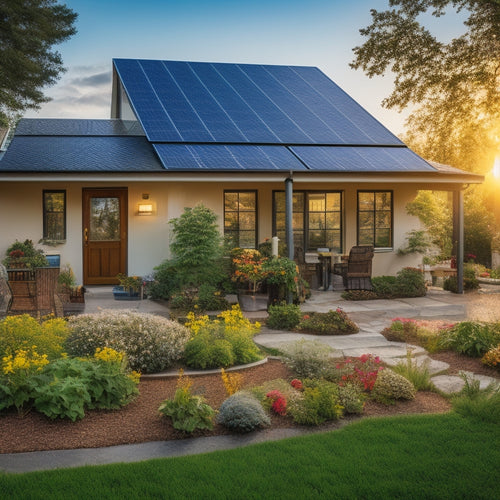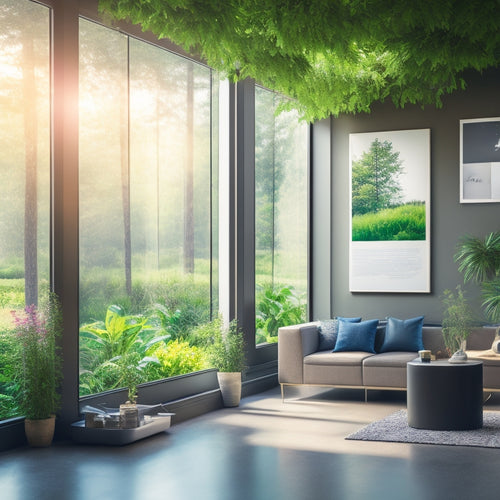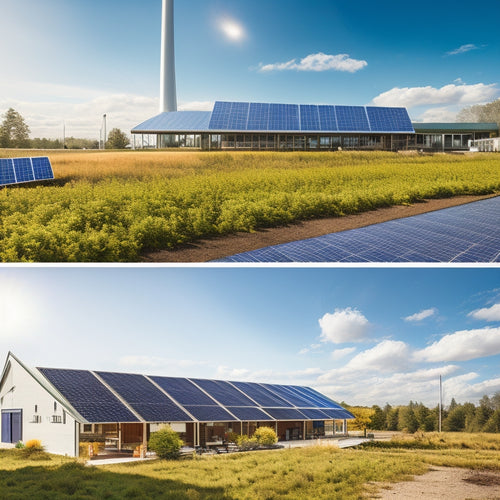
Are Solar Panels Right for You Due to Their 10 Downsides
Share
You're thinking about solar panels, but high upfront costs, intermittent energy generation, and nine other significant downsides may be holding you back from making a decision. You're right to weigh the pros and cons: installation costs can range from $15,000 to $30,000, and solar energy generation is dependent on sunlight availability. Moreover, you'll need to evaluate the substantial space requirements, energy storage costs, inefficient energy conversion, and aesthetic implications. Additionally, you'll need to factor in maintenance requirements, weather damage risks, and the rapidly changing technology that may impact your investment. As you maneuver through these intricacies, it's crucial to get a clearer understanding of what's involved.
Key Takeaways
- High upfront costs, ranging from $15,000 to $30,000, can be a significant barrier to adopting solar panels.
- Intermittent energy generation due to sunlight availability may require backup power sources, affecting overall reliability.
- Energy storage solutions, necessary for consistent power, can add significant costs to the overall investment.
- Solar panels' inefficient energy conversion, with only 15-20% of sunlight converted to usable energy, contributes to energy loss.
- Regular maintenance, including cleaning and inspections, is crucial to ensure optimal energy production and prolong system lifespan.
High Upfront Installation Costs
The initial investment in solar panels can be substantial, with the average cost of installation ranging from $15,000 to $30,000 or more, depending on the size of the system and the quality of the equipment.
You may be wondering how to finance such a significant upfront cost. Fortunately, there are financing options available, such as loans and leases, that can help spread the cost over time. Additionally, you may be eligible for tax incentives and government rebates, which can help offset the initial investment.
It's important to evaluate the installation timelines, as the process can take several weeks to several months. While the high upfront cost may seem intimidating, solar panels can provide significant energy savings over time, reducing your reliance on the grid connection.
Moreover, you'll be making a positive environmental impact. Be sure to research local regulations and warranty coverage before making a decision. Maintenance costs are generally low, but it's vital to incorporate them into your overall cost-benefit analysis.
Intermittent Energy Source
You've made a significant investment in solar panels, but now you're dealing with a fundamental limitation: the sun doesn't always shine. This intermittency is a major concern for solar energy reliability. When the sun is hidden behind clouds or doesn't rise high enough in the sky, your solar panels can't generate electricity.
This means you'll need to rely on alternative power sources, like the grid, to meet your energy needs.
The intermittency of solar energy also creates grid integration challenges. Utilities and grid operators must be able to balance supply and demand in real-time, which becomes more complicated with the variable output of solar panels.
This can lead to grid instability and affect the overall reliability of the power supply. As a result, you may not be able to rely solely on your solar panels for power, and may need to invest in energy storage solutions or backup generators to guarantee a stable supply.
Space Requirements Are Significant
By the time you've installed your solar panels, you'll have realized that they occupy a significant amount of space. This is because the panels need to be placed in a way that maximizes their energy output, considering factors like solar panel placement and roof orientation.
Ideally, your roof should have a southern orientation to receive direct sunlight, and the panels should be installed at an angle that allows for the best energy absorption. However, this often means that a substantial portion of your roof will be dedicated to the solar panels, which can be a challenge for those with smaller roofs or complex rooflines.
Additionally, the space requirements for solar panels can also impact your yard or property. If you have a larger property, you may need to allocate a significant area for the panels, which can affect your overall landscaping and outdoor living spaces.
It's crucial to carefully consider these spatial constraints before investing in solar panels, ensuring that you have sufficient space to accommodate them and still meet your energy needs.
Energy Storage Is Expensive
When you invest in solar panels, you'll likely need energy storage solutions to guarantee a steady power supply when the sun isn't shining.
However, you'll encounter high upfront costs, which can be a significant burden.
Additionally, current battery technology limitations can further complicate the issue, making energy storage a costly and complex aspect of solar panel ownership.
High Upfront Costs
Installing solar panels requires a substantial initial investment, particularly when factoring in energy storage solutions, which can considerably add to the overall cost. You'll need to evaluate the cost of the solar panels themselves, as well as inverters, mounting hardware, and installation labor.
| Component | Average Cost | Range |
|---|---|---|
| Solar Panels | $2.50 per watt | $2.00 - $3.00 per watt |
| Inverters | $1,000 | $800 - $1,200 |
| Mounting Hardware | $1,500 | $1,000 - $2,000 |
| Installation Labor | $2,000 | $1,500 - $2,500 |
While the upfront costs may seem intimidating, you may be able to offset them with financing options and government incentives. For example, the Solar Investment Tax Credit (ITC) allows you to claim a tax credit of 26% of the total cost of your solar panel system. Additionally, many states and utilities offer rebates and other incentives to encourage the adoption of solar energy.
Battery Technology Limitations
While financing options and government incentives can help offset the high upfront costs of solar panels, energy storage solutions add another layer of complexity and expense. As you consider investing in solar panels, it's important to understand the limitations of battery technology.
One significant drawback is the high cost of energy storage systems, which can add thousands of dollars to your overall investment.
Another limitation is the battery lifespan, which typically ranges from 5 to 15 years, depending on the type and quality of the battery. This means you'll need to factor in replacement costs over the long term.
Additionally, charging efficiency is a concern, as it affects how much energy your batteries can store and release. Look for batteries with high charging efficiencies to minimize energy losses.
When evaluating energy storage options, consider the overall cost of ownership, including maintenance, replacement, and charging efficiency.
While advancements in battery technology are promising, it's vital to understand the current limitations and their impact on your investment. By doing so, you'll be better equipped to make an informed decision about whether solar panels are right for you.
Inefficient Energy Conversion
You're likely aware that solar panels don't convert all sunlight into usable energy.
In fact, most commercial solar panels have conversion rates ranging from 15% to 20%, which means a significant amount of energy is lost.
Over time, this inefficiency can be further compounded by energy loss due to degradation of the panels themselves.
Low Conversion Rates
As solar panels convert sunlight into electrical energy, they inherently suffer from low conversion rates, which greatly impact their overall efficiency. You might wonder why this is the case. The reason lies in the physical limitations of photovoltaic cells. They can only convert a fraction of the sun's energy into usable electricity.
| Conversion Rate | Efficiency |
|---|---|
| Commercial Solar Panels | 15-20% |
| Residential Solar Panels | 12-15% |
| High-Efficiency Solar Panels | 20-22% |
| Theoretical Maximum | 34% |
As you can see, even high-efficiency solar panels only manage to convert around 20-22% of the sun's energy. This means that the majority of the energy is lost as heat. While researchers are working on efficiency improvements, the current state of technology limits the potential output of solar panels. Despite this, installation incentives and falling costs make solar panels an attractive option for many.
Energy Loss Over Time
Because solar panels are exposed to environmental stressors like temperature fluctuations, humidity, and UV radiation, their energy conversion efficiency naturally degrades over time. This energy degradation can lead to a significant reduction in the amount of power your solar panel system produces. On average, solar panels lose about 0.5% to 1% of their efficiency annually, which may not seem like a lot, but it can add up over the years.
As a result, you'll need to take into account performance monitoring to guarantee your solar panel system is operating at its peak level. Regular monitoring can help you identify any issues that may be contributing to energy loss, allowing you to take corrective action. This can include cleaning the panels, repairing or replacing damaged components, and adjusting the system's configuration to maximize energy production.
It's essential to incorporate this energy loss over time when determining the overall cost-benefit analysis of installing solar panels. While the initial investment may seem significant, understanding the potential energy degradation can help you make a more informed decision about whether solar panels are right for you.
Solar Panel Maintenance Needed
Regular cleaning of solar panels is vital to guarantee maximum energy output, as dirt and debris can reduce their efficiency by up to 25%. You'll need to set up a maintenance schedule to make certain your panels operate at their best.
| Maintenance Tasks | Frequency |
|---|---|
| Cleaning | Every 6 months |
| Performance monitoring | Monthly |
| Installation inspections | Annually |
You'll need to decide between DIY upkeep and hiring professional services. If you opt for DIY, research gentle cleaning techniques to avoid damaging the panels. If you prefer professional services, factor in the cost when calculating your ROI. Don't forget to review your warranty considerations, as some manufacturers require regular maintenance to maintain the warranty's validity. Long-term care is essential to get the most out of your solar panels. By staying on top of maintenance, you'll make certain your system runs efficiently and effectively, providing you with the power you need.
Aesthetics May Be Unappealing
When you install solar panels, you'll need to evaluate their visual impact on your property.
The size and color of the panels may not complement your home's exterior, potentially affecting its curb appeal.
Additionally, the panels may obstruct your roof's original design, which could be a concern for homeowners who value structural integrity.
Panel Size and Color
Behind the sleek, modern appeal of solar panels lies a potential eyesore: their size and color. You might be surprised to learn that solar panels are quite large, with standard panel dimensions ranging from 39 inches wide to 65 inches long. This can be a significant visual impact, especially if you have a smaller roof or a more ornate design.
When it comes to color options, you're limited to a few standard choices: blue, black, or silver frames with blue or black photovoltaic cells. While some manufacturers offer custom color options, these can be expensive and may not be worth the additional cost.
Additionally, the reflective nature of solar panels can create glare, which can be a nuisance for neighboring properties or pedestrians.
It's essential to reflect on the visual impact of solar panels on your property's aesthetic before making a purchase. You'll want to weigh the benefits of renewable energy against the potential drawbacks of a larger, less visually appealing installation.
Roof Obstruction Concerns
Your rooftop's configuration can greatly impact the installation and performance of solar panels, and obstructions can be a major concern.
Roof design implications, such as multiple skylights, vents, or chimneys, can reduce the available space for solar panels, making it difficult to achieve the best energy output. In addition, these obstructions can cast shadows, resulting in shading effects that further decrease energy production.
You'll need to evaluate the orientation and angle of your roof, as well as any existing features that may obstruct sunlight. For instance, a south-facing roof with minimal obstructions is ideal for solar panels, while a north-facing roof or one with numerous obstructions may not be suitable.
Additionally, you should assess the roof's structural integrity to guarantee it can support the weight of the solar panels.
To mitigate these concerns, you may need to invest in additional hardware, such as microinverters or power optimizers, which can help minimize the impact of shading effects.
Alternatively, you may need to explore alternative solar panel installation options, such as ground-mounted systems or community solar programs.
Battery Replacement Costs
As you investigate the world of solar panels, you'll likely encounter an essential aspect that can greatly impact your overall investment: battery replacement costs.
Solar batteries typically last between 5 to 15 years, depending on the type and quality. When the time comes to replace them, you'll need to factor in the cost, which can range from $5,000 to $15,000 or more, depending on the type and size of the battery bank.
It's crucial to evaluate warranty coverage when purchasing your solar panel system. Look for manufacturers that offer extensive warranties covering battery replacement costs for a significant portion of the battery's lifespan. Some companies also offer extended warranty options for an additional fee.
Additionally, assess the recycling options for your old batteries. Many manufacturers now offer take-back programs or recycling facilities to responsibly dispose of spent batteries.
This not only helps reduce waste but also provides a more sustainable solution for your solar panel system. By understanding the costs and implications of battery replacement, you can make a more informed decision about your solar panel investment.
Weather Damage Is Possible
Solar panels are exposed to various environmental elements, making them susceptible to weather damage. As you consider investing in solar panels, it's crucial to understand the risks associated with weather-related damage. Severe storms can cause significant damage to your solar panel system, leading to costly repairs or even complete system failure.
Hail, in particular, can be a significant concern, as it can crack or shatter panels. However, many modern solar panels are designed with hail resistance in mind, and some manufacturers offer warranties that cover storm impact.
When selecting a solar panel system, look for products that have undergone rigorous testing for weather resistance. Check the warranty and warranty duration to guarantee you're protected in case of weather-related damage.
Additionally, consider investing in a high-quality mounting system that can withstand strong winds and heavy snow loads. By understanding the risks and taking steps to mitigate them, you can minimize the impact of weather damage on your solar panel system.
Technology Is Constantly Evolving
Since the solar industry is rapidly advancing, it's vital to contemplate the implications of developing technology on your solar panel system. You might be wondering how solar advancements will affect your investment. Will it become outdated soon? The answer lies in understanding the pace of renewable innovations.
As you consider solar panels, keep in mind that:
-
Newer technologies might offer higher efficiency rates, making your current system less competitive.
-
Emerging trends, like bifacial panels, could provide more energy output, making your existing system seem less effective.
-
Advancements in energy storage systems might alter the way you store and harness solar energy.
- Future innovations could lead to lower production costs, making newer systems more affordable.
While it's important to acknowledge these potential developments, it's also important to recognize that solar panels are designed to last for decades.
Manufacturers often provide warranties and guarantees to guarantee your system remains efficient and effective throughout its lifespan.
Frequently Asked Questions
Can I Install Solar Panels on a Rented Property?
You'll need to review your rental agreements and obtain your landlord's permission before installing solar panels on a rented property, ensuring you understand any restrictions or requirements for modifications to the rental space.
Do Solar Panels Increase My Property's Value?
You're likely to see an enhancement in your property's value with solar panels, as they can increase its appeal to potential buyers, resulting in a higher resale price, thanks to the solar panel impact on property resale.
Can I Use Solar Panels for Heating My Pool?
As you immerse yourself in the world of solar power, you'll find that solar pool heating is a viable option, offering an efficiency comparison similar to traditional heat pumps, but with a greener twist - and you'll be swimming in savings in no time!
Are There Any Government Incentives for Solar Panels?
You're eligible for solar tax credits, covering up to 26% of your installation costs, and renewable energy grants, which vary by state and locality, to offset the upfront investment, making solar power a more affordable, attractive option for you.
Can I Install Solar Panels on a Metal Roof?
You're a thousand times more likely to succeed with solar panels on a metal roof, as most modern systems are compatible, but you'll need to take into account specialized installation methods, like clamps or brackets, to guarantee a secure and watertight fit.
Conclusion
As you weigh the pros and cons of solar panels, remember that high upfront costs, intermittent energy, and significant space requirements are just the beginning. Add to that expensive energy storage, inefficient conversion, and unappealing aesthetics. Then, factor in battery replacement costs, weather damage, and the constant evolution of technology. With these 10 downsides in mind, ask yourself: are the benefits of solar panels worth the drawbacks, or are they simply a costly indulgence for you?
Related Posts
-

How to Achieve Energy Independence at Home
To achieve energy independence at home, start by investing in renewable energy sources like solar panels, wind turbin...
-

High-Performance Energy-Efficient HVAC Systems
High-performance energy-efficient HVAC systems are essential for reducing energy consumption while improving indoor c...
-

Off-Grid Solar Solutions for Eco-Conscious Businesses
Off-grid solar solutions offer you a path to both sustainability and substantial cost savings. By adopting these syst...


